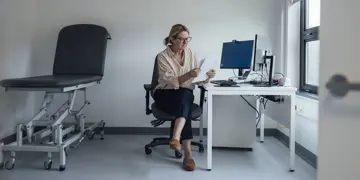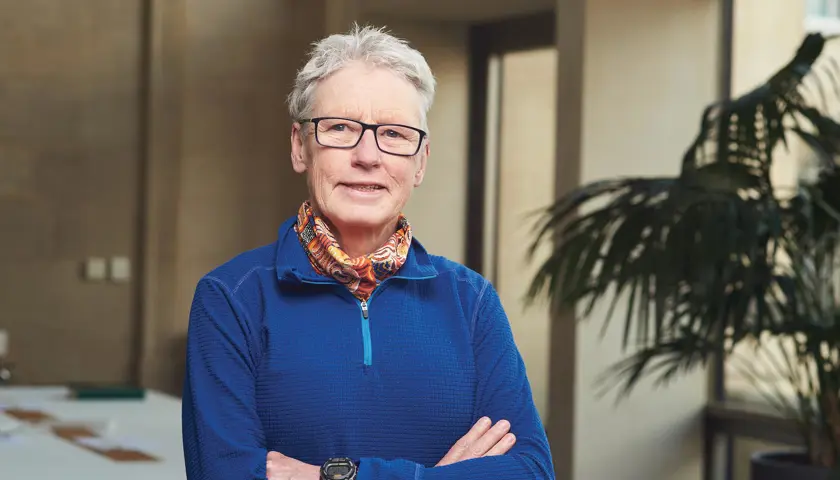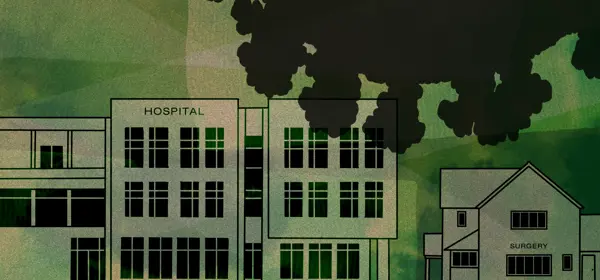The human factor: the effects of remote working on doctor and patient
The human factor: the effects of remote working on doctor and patient
The pandemic saw a rapid shift in general practice towards remote care and many of the innovations remain in hybrid form – but what effect do they have on patients? Two leading GPs set out to find out the answers and came to some worrying conclusions
When Trisha Greenhalgh strained her ribs after ‘overdoing it’ at the gym, one of her colleagues, a sports medicine consultant, suggested an anti-inflammatory treatment. What happened next was a striking reminder of the effects of the increased use of technology in general practice.
The Oxford professor of primary healthcare filled in the online triage form her local GP practice runs and was greeted by a question which read: ‘Do you have chest pain?’ For most people the obvious answer to this question would be ‘yes’ – Prof Greenhalgh says, ‘it was the worst “chest” pain I’d ever had in my life’ – but she knew the correct answer for the purposes of this form was no because yes would mean being told to call 999.
Prof Greenhalgh wrote a note in the free text and explained the situation. Forty-five minutes later she had a text from her GP and a prescription for the drugs she needed. They were already waiting at the pharmacy.
‘For me it was super-efficient. With an educated middle-class patient who knows how to play the algorithm it works. But for so many people they wouldn’t have the health literacy to be able to do that. With digital access there are all these pull-down menus and prior questions and pre-assessments. You have to be able to navigate your way through it. I have a relative who has only a very basic understanding of health and technology, and if they didn’t have me to help them, they would be struggling to get through the digital maze that is now the pathway to their GP,’ she says.
In 2020, as the COVID-19 pandemic hit, primary care shifted heavily to remote care – with a ‘crisis-driven expansion of technology’ making digital booking, triage and information exchange routine. Alongside this, long-term condition monitoring was de-prioritised. Following the acute challenges of the pandemic, general practice restored full services using a blend of remote, digital and in-person care. It has been a period of monumental change, which has taken place in the context of more than a decade of austerity in the public sector, declining numbers of GPs, an ageing population, rising levels of multi-morbidity and increasing inequalities.
For Prof Greenhalgh and colleagues these developments raised a question which has not been previously answered by academic study: how have changes in technologies and working practices affected the quality in UK general practice?
Extensive research
To answer that question, a team of researchers were embedded in 12 GP practices, which they observed for 28 months – following and interviewing staff and patients as well as assessing documents and data. This in-depth work was combined with interviews of stakeholders in strategic local and national roles, analysis of the GP patient survey and online reviews by patients, a ‘multi stakeholder workshop’ on quality and safety, assessment of the Care Quality Commission’s state of care reports and the Health Services Safety Investigations Body’s report on continuity of care and delayed diagnosis.
Prof Greenhalgh says that, when designing this new study, she had been struck by previous studies which had looked at the effect of remote and digital care on large numbers of practices but had not been able to explain why those effects varied so much from practice to practice. ‘I thought we needed to study fewer practices, but in more depth,’ she says. ‘Our idea was to sample just 12 practices but get to know each of them in depth and follow it over time. That meant we could actually paint a picture. We didn’t produce much quantitative data, we can’t say “the answer is 42.3”, but we found that certain problems affected all the practices and some practices were able to overcome some problems and some weren’t. It’s a slightly unusual study design, but I think it’s one of the most successful research studies I’ve ever been involved with.’
Rebecca Payne, a GP and the Reuben-Clarendon doctoral scholar at Oxford University, was one of the leaders of the project. She says the ‘digital aspects’ of general practice haven’t been talked about enough and her sense that, while things might look more efficient with technological processes and that actually they often aren’t, was the driving force for her involvement.
Our idea was to sample just 12 practices but get to know each of them in depth and follow it over time. that meant we could actually paint a picture
Dr Greenhalgh
The study’s findings are striking. It shines a light on the increasingly difficult context of delivering quality in general practice – characterised by financial austerity, loss of resilience, increasingly complex patterns of illness and need, an increasingly fragmented workforce, material and digital infrastructure unfit for purpose and fewer in-person interactions.
The study also suggests most clinicians and support staff still aspire to traditional values of general practice like relationship-based, compassionate care and continuity but providing the human elements of care is increasingly challenged.
A partner at one of the GP practices involved in the study told The Doctor: ‘It has been incredibly hard but in my experience many of us have stepped back and really thought, “why are we doing this?” And then you remember why you’re doing it and that hasn’t really changed. Our core belief is that we’re in it for the community, for the whole person, for their whole family, for the whole journey – their whole life.’
On technology, and the benefits of hybrid services, many patients and staff reflected positively about convenience and flexibility – and other positives such as patients being able to submit blood-pressure readings were also raised.
Unintended consequences
Dan Beck is a GP at the Swiss Cottage surgery in north London, which has implemented an online tool that provides three or four text boxes for patients to explain their symptoms and what sort of responses they would like from staff. One GP at the surgery will – during normal hours – be assessing the forms and triaging patients and is often able to assess requests within 30 minutes before working out what type of consultation is required. The practice tries to provide continuity by allowing patients to request a named GP where possible.
There is still a team of receptionists who direct callers to the online tool but are able to help where patients need more assistance. ‘Our online tool isn’t a substitute for clinical interaction,’ Dr Beck says. ‘It simply allows us to put patients in the right place, make sure queries are getting through, and patients are getting what they need.’
Dr Beck recognises there is no system which works for all patients but here this seems to be a success. ‘We’re really proud of our offer for patients,’ he says. ‘I don’t think you can bring in a tool like this if your practice is really struggling and expect it to make your demand/capacity profile more balanced … but it can help you match your capacity to your demand.’
However, the work also reveals digital access and triage systems and multiple new staff roles designed to increase efficiency appear to have introduced many new inefficiencies as well as compromising quality, accessibility, patient-centredness and equity of care. The list of unintended consequences found is stark – including patients submitting multiple requests as triaging systems could only deal with one at once, skilled staff being needed for triaging, which reduced capacity elsewhere and the rapid pace and high risk associated with triage increasing staff stress leading to burnout, sickness absence and staff turnover.
A GP partner at one of the practices, whose practice operates a hybrid system, said there are ‘strengths for some people’ but that technology can mean feeling ‘surrounded’ by structures when what you really want is to be seeing patients and that pressures to move to total triage could adversely affect lots of parts of their population.
‘What are we doing?’
The study also found the quality of long-term condition management varies wildly, with some practices reintroducing in-person reviews while others rely on remote data entry by patients with care fragmented across different staff members with ‘limited training’.
One of the most powerful parts of the study shows how the changes have crystallised the theory of the inverse care law, with the supporting revelation that efforts to improve equity and mitigate digital exclusion, like digital navigators, help in some areas but do not compensate for complexity of systems and extremes of structural disadvantage.
Dr Payne says: ‘I think, for me, being really deep in the data, it was the most depressing thing I have ever written in my life. It was the sort of thing that makes you think, what are we all doing? All of these things you encounter as a GP in your clinical practice, but to have it all there in front of you and leaping out of the data … It was so depressing.’
While the study hasn’t produced huge amounts of quantitative data that leads to easy action points and immediate actions to address concerns, there must be many lessons to learn from such striking findings.
Dr Payne says: ‘This is a call for holistic, relationship-based healthcare – not just a relationship with the patient but with the community and between individuals in the practice. We’ve replaced relationships with technology and we’re not getting what we need from that.’
Prof Greenhalgh adds: ‘Can we please just be there for people and be their doctors in a holistic way – looking after the individual, the family and the community and doing all the kinds of things around education and behaviour that we did in the old days. This approach was actually far more sophisticated than most of us realised. Now it’s been transactionalised and we’re beginning to realise what we’ve lost.’
The study was conducted by: Rebecca Payne, Francesca H Dakin, Aileen Clarke, Nadia Swann, Jackie van Dael, Natassia Brenman, Rebecca Rosen, Adam Mackridge, Lucy Moore, Asli Kalin, Emma Ladds, Nina Hemmings, Sarah Rybczynska-Bunt, Stuart Faulkner, Isabel Hanson, Sophie Splitters, Sietse Wieringa, Sara E Shaw, Joseph Wherton, Richard Byng, Laiba Husain and Trisha Greenhalgh.





